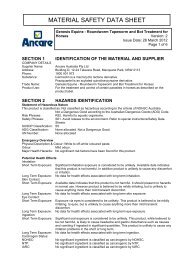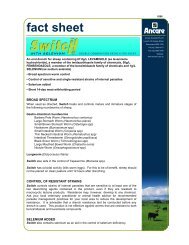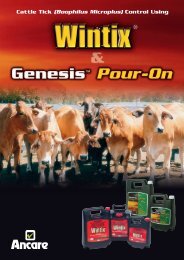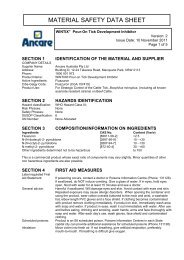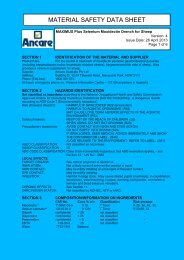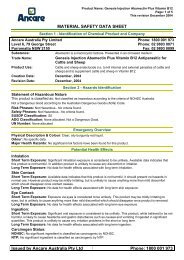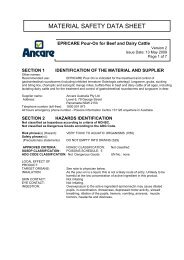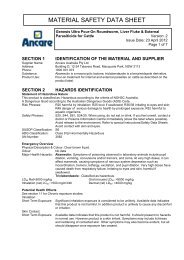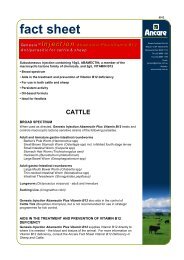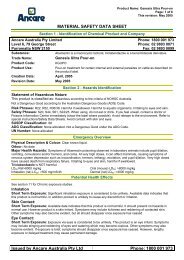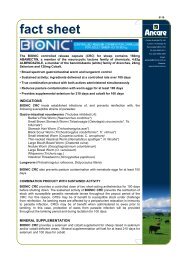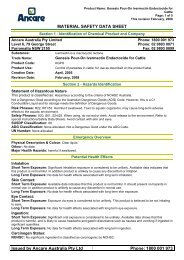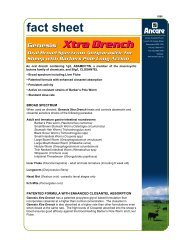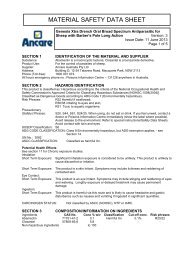SEQUEL Fact Sheet - Ancare
SEQUEL Fact Sheet - Ancare
SEQUEL Fact Sheet - Ancare
You also want an ePaper? Increase the reach of your titles
YUMPU automatically turns print PDFs into web optimized ePapers that Google loves.
1212<br />
fact sheet<br />
<strong>Ancare</strong> Australia Pty Ltd<br />
Building D, 12-24 Talavera Rd<br />
Macquarie Park NSW 2113<br />
Ph (02) 9893 0071<br />
Fax (02) 9893 0099<br />
genesis@ancare.com.au<br />
www.ancare.com.au<br />
A dual combination oral drench for sheep containing 1g/L ABAMECTIN, a<br />
member of the macrocyclic lactone family of chemicals (mectin drenches) and<br />
40g/L LEVAMISOLE (as levamisole hydrochloride), a member of the<br />
imidazothiazoles family of chemicals (clear drenches). It also contains 0.5g/L<br />
SELENIUM (as sodium selenate) and 2.2g/L COBALT (as cobalt disodium<br />
EDTA).<br />
• Broad spectrum<br />
• Short acting combination drench<br />
• Controls BZ, levamisole and ML resistant worms^<br />
• Standard 1mL per 5kg dose rate<br />
COMBINATION POWER<br />
<strong>SEQUEL</strong> Abamectin/Levamisole Combi Drench contains two short acting<br />
ingredients. Abamectin is more potent than ivermectin and has a short chemical tail.<br />
Levamisole has good efficacy against Haemonchus and Cooperia, the species mectins<br />
find hard to kill. At the recommended dose rate, <strong>SEQUEL</strong> treats and controls the<br />
following sheep roundworms, sensitive to at least one of the two deworming agents<br />
contained in the product:<br />
Adult and immature gastro-intestinal roundworms<br />
Barbers Pole Worm (Haemonchus contortus)*<br />
Small Brown Stomach Worm (Teladorsagia [Ostertagia] circumcincta)*<br />
Stomach Hair Worm (Trichostrongylus axei)*<br />
Black Scour Worm (Trichostrongylus spp)*<br />
Small Intestinal Worm (Cooperia spp)*<br />
Thin Necked Intestinal Worm (Nematodirus spp)<br />
Hookworm (Bunostomum trigonocephalum)<br />
Intestinal Threadworm (Strongyloides papillosus)<br />
Large Bowel Worm (Oesophagostomum venulosum)<br />
Large Mouthed Bowel Worm (Chabertia ovina)<br />
Nodule Worm (Oesophagostomum columbianum)<br />
Whipworm (Trichuris ovis)<br />
* including inhibited fourth stage larvae<br />
<strong>SEQUEL</strong> also provides a selenium and cobalt supplement for sheep raised in selenium<br />
and/or cobalt deficient areas<br />
ASSISTS IN THE MANAGEMENT OF CHEMICAL RESISTANCE<br />
Resistance may develop to any drench. However, studies have shown that using<br />
combination drenches, such as <strong>SEQUEL</strong>, can significantly delay the development of<br />
resistance. <strong>SEQUEL</strong> is active against sheep roundworms that have single resistance<br />
to the benzimidazole, imidazothiazole (levamisole) or macrocyclic lactone^ families of<br />
chemicals. It is advisable that a drench-resistance test be conducted before any drench<br />
is used.
STANDARD DOSE RATE<br />
The dose rate of 1mL/5kg bodyweight is the same low dose of traditional drenches and application is by<br />
the oral route using any standard drenching equipment. At the given dose rate, <strong>SEQUEL</strong> delivers 0.2mg<br />
abamectin, 6.8mg levamisole (8mg levamisole hydrochloride), 0.1mg selenium and 0.44mg cobalt per kg<br />
bodyweight.<br />
Bodyweight Dose 5 Litre Treats 15 Litre Treats<br />
DO NOT treat lambs under 15kg.<br />
16 to 20kg 4mL 1250 3750<br />
21 to 25kg 5mL 1000 3000<br />
26 to 30kg 6mL 833 2500<br />
31 to 35kg 7mL 714 2142<br />
36 to 40kg 8mL 625 1875<br />
41 to 45kg 9mL 555 1666<br />
46 to 50kg 10mL 500 1500<br />
51 to 55kg 11mL 454 1363<br />
56 to 60kg 12mL 416 1250<br />
61 to 65kg 13mL 384 1153<br />
66 to 70kg 14mL 357 1071<br />
71 to 75kg 15mL 333 1000<br />
Dose animals heavier than 75 kg at 1 mL per 5 kg<br />
Re-treatment interval: DO NOT re-treat animals for 6 weeks after last treatment.<br />
ANIMAL SAFETY<br />
<strong>SEQUEL</strong> should not be used when selenium intake from pasture is high or selenium is provided by other<br />
means (such as pasture top dressing, vaccine, pellets or selenium drenches) if blood selenium levels at<br />
treatment are high. Users can determine the sheep’s selenium status by consulting their veterinarian.<br />
Selenium can have toxic effects, particularly in sheep with liver damage that graze in areas where plants<br />
containing pyrrolizidine alkaloids (e.g. heliotrope and Paterson’s curse) are present. Do not add additional<br />
selenium to the drench and do not use at the same time as other selenium treatments (e.g. selenised<br />
vaccines, drenches or pellets, pasture top dressing) without consulting a veterinarian. Do not administer<br />
selenium supplements at intervals less than three weeks or within one year of long-term selenium bullet or<br />
capsule treatment.<br />
Because <strong>SEQUEL</strong> contains levamisole, exercise care in handling weak, pregnant and young animals to<br />
avoid unnecessary stress. Avoid yarding animals off-feed overnight, and ensure animals have access to<br />
water when yarded prior to drenching. Stress and lack of feed or water may enhance the chance of<br />
levamisole toxicity, even with the recommended dose. Recommended dose should not be exceeded,<br />
except under veterinary supervision.<br />
Do not administer <strong>SEQUEL</strong> to sheep that are dehydrated or unwell and do not use in lambs under six<br />
weeks of age or less than 15kg bodyweight.<br />
WITHHOLDING PERIODS<br />
MEAT: 14 days<br />
EXPORT SLAUGHTER INTERVAL (ESI): 42 days<br />
MILK: DO NOT USE in sheep which are producing or<br />
may in the future produce milk where the milk or milk<br />
products may be used for human consumption.<br />
PACK SIZES AVAILABLE<br />
5L Backpack<br />
15L Drum<br />
^Claim for control of ML-resistant worms subject to APVMA<br />
approval at time of printing.



